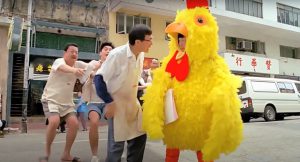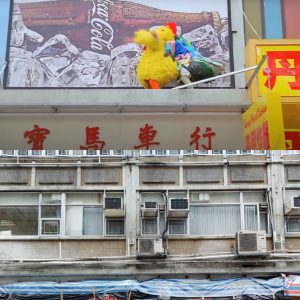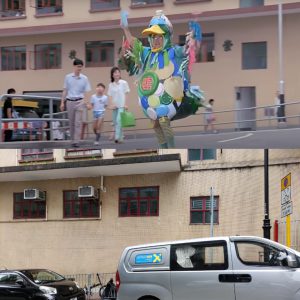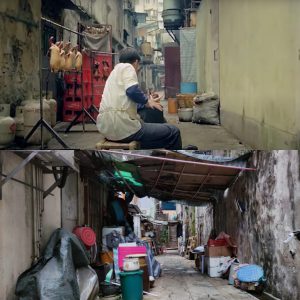CHICKEN AND DUCK TALK, DIR. MICHAEL HUI (1988)
Yan Hing Street, Tai Po, Hong Kong

Michael Hui talks to his former staff in Danny’s Chicken cosplay outfit in Yan Hing Street. Scenes from Chicken and Duck Talk, 1988, directed by Michael Hui.
Chicken and Duck Talk took place at Yan Hing Street, with the Hui Lo Gei roast duck and Danny’s chicken restaurant on the opposite sides. The film portrayed Yan Hing street as a crowded and noisy place, the pedestrian road was filled with neighborhood and students, serving as a foundation for the competition between the two restaurants. Just by observing from the street, the structure of most buildings were kept the same, some windows were changed, protruding signboards were removed and facades were repainted. However, the atmosphere was totally the opposite. Rather than a lively street, it was quite silent. Shops were changed to car maintenance stores and people were replaced by empty cars, the colored windows were gone, even the red gate in front of the Hong Kong Railway Museum was locked because of the pandemic, and so the queue disappeared. The extended shelter where the duck chased the chicken was removed too. Surprisingly, other than the drainage on the right, the back alley where Michael Hui roasted the ducks seem retained through these years. The messiness and wear were still here, household items such as buckets and clothes were as usual randomly scattered around the space, bringing on pure nostalgia.
The comedy depicted the chicken shop’s manager was harsh and cruel to staff, giving them robotic training and told them to sacrifice their dignity in order to meet marketing needs for the company. In comparison, in the duck shop, employer and employees chat together and share the same food as if they were a family, portraying Hong Kong as a warm and friendly place. Obviously, the director would choose a place with these characteristics. In the 80s, the red gate led to the Tai Po Market railway station instead of a museum, which stimulated pedestrian flow across the street. This attracted cha chaan tengs, pawn shops and car repair shops to locate their business there. However, since Tai Po Market railway station was classified as declared monuments, the station had transformed to a museum. Less people were visiting the place and local companies couldn’t withstand the loss of customers, as a result, the once existed Hui Lo Gei roast duck restaurant was not there. The same space enclosed by two sides of the buildings changed from a colorful picture to a dull walkway. It shows that time changes and takes away space, even keeping the same architecture and urban planning, time determines the meaning of space, explaining how architecture is discovered by time.
In terms of cinematic techniques, the movie used a lot of close up shots and a full view of the street was hardly to be found. The film used limited angles, mainly the perspective of the L turn at the red gate and the view to the opposite stores, other scenes were just shot inside Hui Lo Gei. This technique creates a cozy and homey impression and first person narration to the audience, framing the space in a small scale. This highlights delicate things such as cutlery, furniture, walls, cars and characters, letting audience to familiarize with small things, just like how we remember the details in our own room. Yet, it is hard to experience the quality of this microscopic space in reality especially when can’t even see a restaurant. Even the distribution of stores remained mostly unchanged, the warmth in-between people is immersed into the small objects in the movie. It is difficult to recreate this experience in reality by looking at the infrastructure, columns, walls and stairs, while film captures and freezes these precious moments of architecture, this small scale framing of space made this old Hong Kong film so valuable.
— Joseph Wong (3035792779)


- Top: perspective of Yan Hing Street. Scenes from Chicken and Duck Talk, 1988, directed by Michael Hui.
- Bottom: perspective shot of Yan Hing Street, 2021.


Top: facade of buildings on Yan Hing Street. Scenes from Chicken and Duck Talk, 1988, directed by Michael Hui. Bottom: repainted and renewed facades of buildings on Yan Hing Street, 2021.

Top: back alley of Michael Hui roasting duck, Yan Hing Street. Scenes from Chicken and Duck Talk, 1988, directed by Michael Hui. Bottom: view of back alley, Yan Hing Street, 2021.

Top: the red gate leading to the old Tai Po Market railway station, Yan Hing Street. Scenes from Chicken and Duck Talk, 1988, directed by Michael Hui. Bottom: the red gate leading to the Hong Kong railway museum, Yan Hing Street, 2021.
Wong Jing Hymn, Joseph
3035792779
Appreciate your opening reflection on Yan Hing Street in the film and during the pandemic when you conduct the fieldwork, and how the everyday items invoke a sense of nostalgia. Is there a reason for your emphasis i.e. “pure nostalgia” (other than simply, nostalgia)? Could be meaningful to clarify this a little? Or, is your next paragraph where you reflect on the idea that despite the continual existence of the architecture and their spaces, the people and the activities that once made the street lively and noisy are no longer there. It would be good at this juncture to consider what new activities or spaces reappear in their places in a critical reflection of how, in your words, “architecture is discovered by time.” It is interesting that the back alley in the late 1980s film still exists and still contains many objects that show that it continues to be inhabited and domesticated. What are the similarities and differences after three decades? And as you have pointed out, the film’s use of focused and close-up shots offers a sense of intimacy and gives the audience a “cozy and homey” impression of the spaces of everyday life. A reflection of the issues you have raised through the class readings on Abbas and de Certeau could offer further depth to your observational analysis.